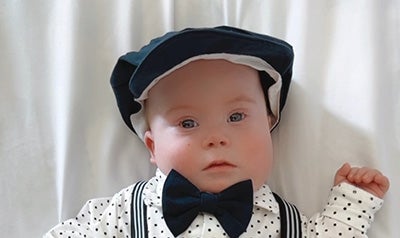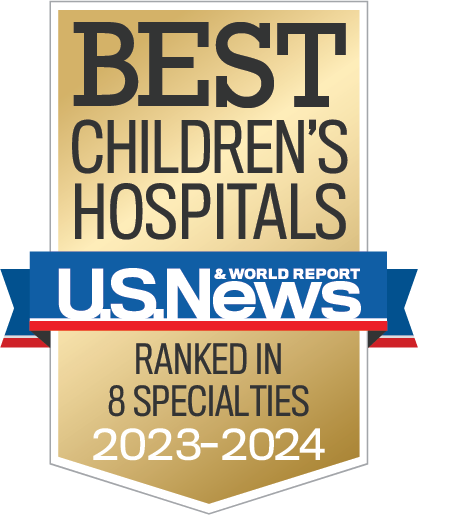Pulmonary hypertension, Down syndrome
Tomas and Kirstin Czernek had always planned to adopt. They adopted their oldest two children, Mia and Kai, before having their next daughter, Aria, who was born with Down syndrome. “She is such a joy in our lives and is amazing in so many ways,” Kirstin said. “Having her really grew our love for the Down syndrome community at large.”
When the couple began thinking once again about adoption, they knew they wanted to adopt a baby with Down syndrome. What they didn’t expect, however, was the medical rollercoaster they would immediately go on upon the baby being born.
After spending a couple of years waiting to be matched, the couple, who reside in Florida, got connected with a soon-to-be mother in Alabama. “We built a relationship with her, and we got to be in the room for Luca’s delivery,” Kirstin explained. “When he was born, he was very limp and unresponsive. Doctors tried to stimulate him, but he was barely moving and turning blue. They instantly got him on respiratory support, but it became obvious very quickly that he wasn’t doing well.”
Doctors worked to have Luca transported to Children’s of Alabama in Birmingham. After the couple were able to quickly tie up legal issues—the only way they could accompany Luca to Children’s was if the birth mother signed over her rights immediately—they were on their way to determine what was wrong with their new baby. “We showed up at Children’s, and I was immediately relieved,” Kirstin said. “Within five minutes of meeting everyone and watching them assess Luca, I knew that everything would be OK.”
Luca was diagnosed with severe pulmonary hypertension, a life-threatening condition that affects the lungs and heart. Doctors kept Luca on the ventilator for multiple days—on the highest setting, at that—but he wasn’t making any progress. In fact, he took a turn for the worst. Doctors let the family know that Luca would have to go on ECMO, or extracorporeal membrane oxygenation, a heart-lung bypass machine that helps critically ill or injured patients by providing oxygen to their blood while allowing their heart and lungs to heal or rest. “I was terrified because I knew the risks involved,” Kirstin said. “And we had only known Luca for a few days, and here we were making those life-altering decisions for him. It was overwhelming, but that doctor sat down with us and helped us get comfortable in moving forward.”
Luca was placed on ECMO, where he stayed for 10 days. With no complications, doctors were able to take him off and put him back on the ventilator in hopes that he would soon begin to breathe completely on his own. “He did really well on ECMO, but he just wasn’t getting better,” Kirstin said. “Then in walks Dr. [Carl] Coghill, and he was our saving grace. From that point on, I feel like Luca turned the corner. The way Dr. Coghill approached Luca’s care was a game changer.”
Coghill, the medical director of the Children’s neonatal intensive care unit (NICU), says each member of Luca’s care team played an important role.
“This was a very complicated case requiring the entire team at Children’s of Alabama, including the parents, bedside nurses, nurse practitioners and care coordinators as well as an array of subspecialty services and allied health professionals,” he said.
It took some trial and error, but over the next two months, Luca slowly improved. Tests soon revealed he no longer had pulmonary hypertension, and the conversation began centering around going home. But that’s when doctors discovered another issue: chylothorax, a condition often developed because of ECMO, in which fluid leaks into the space around the lungs. “Doctors started the process to drain the fluid, and it added about six more weeks to our stay,” Kirstin added. “We went from one medical journey into another. But he took a lot of strides in the right direction, and we finally got to start putting together a discharge plan.”
After three months in the hospital, Luca was able to go home to Florida for the first time and meet his three awaiting siblings. “The kids just adore him,” Kirstin said. “They have the sweetest relationship. We didn’t know what the dynamics would be—they had to deal with a new brother being born and then immediately that keeping their parents away from them for weeks at a time. But there has never been an issue. They just adore him.”
Luca continues to improve. Though he’s experienced a few developmental delays, he’s continued physical, speech and occupational therapies, which he started while at Children’s. “I just can’t say enough about Children’s,” Kirstin said. “He’s done amazing, and we know that is thanks to the staff at Children’s. The doctors, nurses and everyone there truly care about their patients but also about the family, too. Children’s has created a really unique and special place, and we’re so thankful for it.





